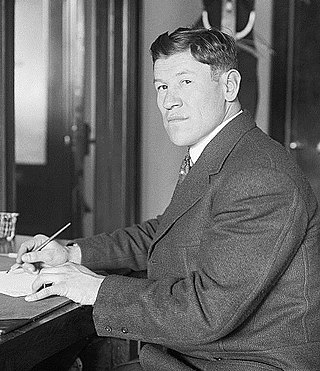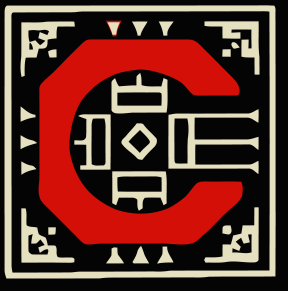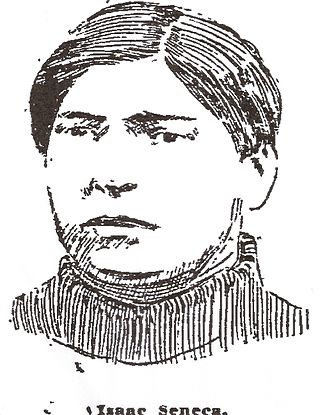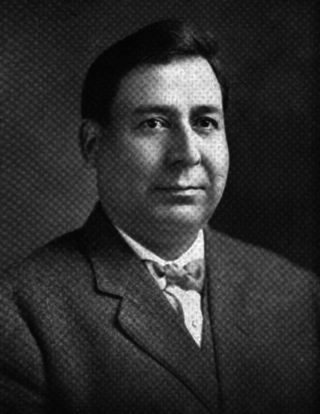
James Francis Thorpe was an American athlete and Olympic gold medalist. A citizen of the Sac and Fox Nation, Thorpe was the first Native American to win a gold medal for the United States in the Olympics. Considered one of the most versatile athletes of modern sports, he won two Olympic gold medals in the 1912 Summer Olympics. He also played football, professional baseball, and professional basketball.

Carlisle is a borough in and the county seat of Cumberland County, Pennsylvania, United States. Carlisle is located within the Cumberland Valley, a highly productive agricultural region. As of the 2020 census, the borough population was 20,118; including suburbs in the neighboring townships, 37,695 live in the Carlisle urban cluster. Carlisle is the smaller principal city of the Harrisburg–Carlisle metropolitan statistical area, which includes Cumberland and Dauphin and Perry counties in South Central Pennsylvania.

Glenn Scobey Warner, most commonly known as Pop Warner, was an American college football coach at various institutions who is responsible for several key aspects of the modern game. Included among his innovations are the single and double wing formations, the three point stance and the body blocking technique. Fellow pioneer coach Amos Alonzo Stagg called Warner "one of the excellent creators". He was inducted as a coach into the College Football Hall of Fame as part of its inaugural class in 1951. He also contributed to a junior football program which became known as Pop Warner Little Scholars, a popular youth American football organization.

The United States Indian Industrial School in Carlisle, Pennsylvania, generally known as Carlisle Indian Industrial School, was the flagship Indian boarding school in the United States from its founding in 1879 through 1918. It was based in the historic Carlisle Barracks, which was transferred to the Department of Interior from the War Department for the purpose of establishing the school. More than 7,800 children from 140 Indian tribes were separated from their communities and sent to the school. After the United States entered World War I, however, the school was closed, and the property on which it was located was transferred back for use by the U.S. Department of Defense. The property is now part of the U.S. Army War College, and it was designated a national monument by President Joe Biden in December 2024. Carlisle Federal Indian Boarding School National Monument will be co-managed by the Army and the National Park Service in consultation with tribes.

Carlisle Barracks is a United States Army facility located in Pennsylvania, with a Carlisle post office address and with a portion in Carlisle, Pennsylvania. The site of the U.S. Army War College, it is the nation's second-oldest active military base. The first structures were built in 1757, during the French and Indian War between Great Britain and France in the colonies.

Joseph Napoleon "Big Chief" Guyon was an American Indian from the Ojibwa tribe (Chippewa) who was an American football and baseball player and coach. He played college football at the Carlisle Indian Industrial School from 1912 to 1913 and Georgia Tech from 1917 to 1918 and with a number of professional clubs from 1919 to 1927. He was inducted into the Pro Football Hall of Fame in 1966 and the College Football Hall of Fame in 1971.

Robert Cook Folwell Jr. was an American football player and coach. He served as the head coach at Lafayette College (1909–1911), Washington & Jefferson College (1912–1915), the University of Pennsylvania (1916–1919), and the United States Naval Academy (1920–1924), compiling a career college football record of 106–29–9. Folwell then moved to the professional ranks, coaching the New York Giants of the National Football League (NFL) in 1925, the Philadelphia Quakers of the American Football League in 1926, and the Atlantic City Roses of the Eastern League of Professional Football in 1927.
Francis Arthur "Mother" Dunn, was an American football player as well as head football coach for at Dickinson College in Carlisle, Pennsylvania. While coaching at Dickinson he also played professional football for the Canton Bulldogs. After coaching he served as a corporate attorney in the steel industry until he retired in 1969

Franklin Pierce Mount Pleasant Jr. was a Native American football player, track and field athlete, and coach of football, basketball, and baseball. He played college football at the Carlisle Indian Industrial School and Dickinson College and graduated from Dickinson in 1910. He was the first Native American to graduate from Dickinson. He made the 1904 and 1908 US Olympic track teams, placing sixth in the triple jump and long jump at the 1908 Summer Olympics.
The Carlisle Indians football team represented the Carlisle Indian Industrial School in intercollegiate football competition. The program was active from 1893 until 1917, when it was discontinued. During the program's 25 years, the Indians compiled a 167–88–13 record and 0.647 winning percentage, which makes it the most successful defunct major college football program. During the early 20th century, Carlisle was a national football powerhouse, and regularly competed against other major programs such as the Ivy League schools. Several notable players and coaches were associated with the team, including Pop Warner and Jim Thorpe.

Thomas Leo "Ted" St. Germaine was an American football player, coach, and lawyer. He served as the head football coach at Villanova College—now known as Villanova University—for one season, in 1913, compiling a record of 4–2–1. Germaine played professionally in the National Football League (NFL) during the 1922 season. That season, he joined the NFL's Oorang Indians, a team based in LaRue, Ohio, which was composed solely of Native Americans, and coached by Jim Thorpe. St. Germaine was qualified to play for the Indians since he was a Chippewa.

Isaac Seneca Jr. was an All-American football player for the Carlisle Indian Industrial School. He was selected as an All-American halfback on the 1899 College Football All-America Team. He was the first Carlisle player and the first American Indian to be selected as an All-American. He was born in 1874 on the Cattaraugus Reservation in New York.

Martin Frederick Wheelock was an American college football player who achieved a national reputation while playing for the Carlisle Indian School from 1894 to 1902. Captain of the 1899 Carlisle Indians football team, Wheelock was selected as a first-team All-American by the New York Sun in 1899, a second-team All-American by Walter Camp in 1901, and to the All-University Team by the Philadelphia Inquirer in 1902. In later life, he worked as a blacksmith and farmer.

Dennison Wheelock was an Oneida band conductor, composer, and cornet soloist. Wheelock was the most prominent Indian American band leader of the turn of the century and was nominated to serve as the bandmaster of the United States Marine Band. At the age of 40 he became an American Indian rights activist and attorney, and within several years was arguing cases for Indian nations at the United States Court of Claims and US Supreme Court.
Oscar Hiram Lipps worked at the Carlisle Indian School in Pennsylvania, was superintendent of the Nez Perce Agency, was superintendent at the Chemawa Indian School, and was a field representative of the U. S. Indian Service. He wrote a two volume book on the Navajo. The University of Oregon has a collection of his papers.

Chief Chauncey Yellow Robe was a Sičhą́ǧú educator, lecturer, actor, and Native American activist. His given name, Canowicakte, means "kill in woods," and he was nicknamed "Timber" in his youth.

Emma Kickapoo Williams Ellis was a Native American woman of the Mexican Kickapoo, known as a model for several artists. She took an allotment in Indian Territory, was educated at the Carlisle Indian Industrial School, in Carlisle, Pennsylvania and became a baker. In 1912, she was one of three Kickapoo models for Edward Warren Sawyer, who made a bronze cast of her image for the Smithsonian. The following year, she was the sole tribal member willing to accept a United States Flag from the Wanamaker Expedition. Her image posing with it was chosen for the cover of the 1971 book American Indian Portraits from the Wanamaker Expedition of 1913, which published the photographic collection taken during the expedition. In 1931, she sent a photograph of herself and a quilt she made to Franklin D. Roosevelt, which was featured in volume 15 of the series Handbook of North American Indians published in 1978 by the Smithsonian.

Meyer Bloomfield was an American lawyer and social worker.
Nelson Drue Simons (1885-1953) was a Mashpee Wampanoag Tribe chief from 1916 to 1928 and government official who was also the first known Native American graduate of Suffolk University Law School in Boston.















